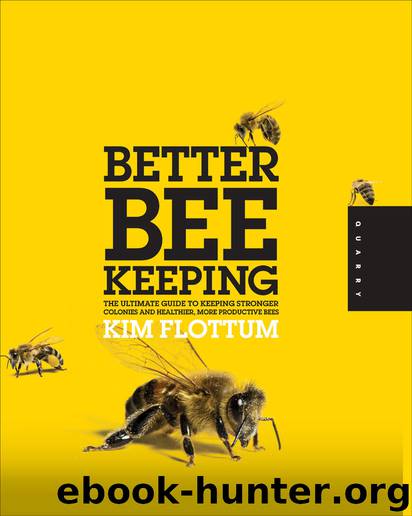Better Beekeeping by Kim Flottum

Author:Kim Flottum
Language: eng
Format: epub
Publisher: Rockport Publishers
Published: 2011-01-23T05:00:00+00:00
This was one of the good ones. She was advertised as an Italian, looked like one, behaved like one, and produced like one. She was everything I expected, and I got what I paid for from the commercial queen producer I bought her from.
Raising Drones
Drones are without a doubt the weakest link in the chain of producing perfect queens.
The only time you know for sure the background of the drones your queens are mating with is when you have carefully selected their mother, tested her other offspring for the traits you are interested in, checked the consistency of her offspring, and then made a single-drone instrumental insemination mating. Then you know. Otherwise you don’t. But that’s unrealistic when running a busy business.
You can stack the deck in your favor by flooding the area your virgin queens inhabit during their mating flights with drones you are comfortable with. This way your queens get an acceptable level of appropriate couplings. How many appropriate matings do you need to get a queen that produces the bees you want?
It comes down to the drones. To get the right number of drones, of the right age, in the right place at the right time in the right condition is probably the most complicated part of this task, and it deserves some attention.
The USDA determined that to maintain European colonies in areas considered occupied by Africanized honey bees, a beekeeper should have 60 drone mother colonies in the surrounding area for every 1,000 mating virgin queens. This same ratio would be required in any area if you want your virgin queens to mate with known drones you have bred and placed in the drone mother colonies in the area.
This saturation level is beyond the reach of nearly every backyard and small-scale sideline beekeeper. Think of the resources this would require in just the drone mother colonies. You can fudge those numbers if you are not raising 1,000 virgin queens, but you can’t fudge them much because this many colonies not only provide the number of drones needed (20,000 for 1,000 queens), but they also cover the entire area your virgin queens will be mating in. So not only do you need density, but you also need area. It isn’t as simple as ratcheting down the number of drone mother colonies needed to accommodate your 100 queens from 60 to 6. You still should be covering the same area those 60 colonies would cover.
Here’s something that is seldom mentioned. If you have, say, five breeder queens producing production queens, you should have some of those same genetics represented in the drone population you present to those virgin queens. But if there are too many, inbreeding creeps in. So, what drone genes do you supply? Here’s a way to think of this. In your evaluations of many breeders you will test, say, fifteen breeders from several sources. Of these, six or seven will make the grade. Half then go to producing virgin queens and half go to producing drone colonies.
Download
This site does not store any files on its server. We only index and link to content provided by other sites. Please contact the content providers to delete copyright contents if any and email us, we'll remove relevant links or contents immediately.
Craft Beer for the Homebrewer by Michael Agnew(17921)
Marijuana Grower's Handbook by Ed Rosenthal(3507)
Barkskins by Annie Proulx(3189)
Project Animal Farm: An Accidental Journey into the Secret World of Farming and the Truth About Our Food by Sonia Faruqi(3006)
Red Famine: Stalin's War on Ukraine by Anne Applebaum(2811)
The Plant Messiah by Carlos Magdalena(2743)
0041152001443424520 .pdf by Unknown(2584)
Organic Mushroom Farming and Mycoremediation by Tradd Cotter(2561)
In the Woods by Tana French(2389)
Beer is proof God loves us by Charles W. Bamforth(2243)
7-14 Days by Noah Waters(2239)
The Art of Making Gelato by Morgan Morano(2159)
Meathooked by Marta Zaraska(2137)
Reservoir 13 by Jon McGregor(2133)
Birds, Beasts and Relatives by Gerald Durrell(2125)
Borders by unknow(2111)
The 7 Habits of Highly Effective People: Powerful Lessons in Personal Change (25th Anniversary Edition) by Covey Stephen R(2078)
Between Two Fires by Christopher Buehlman(2017)
The Lean Farm Guide to Growing Vegetables: More In-Depth Lean Techniques for Efficient Organic Production by Ben Hartman(2006)
